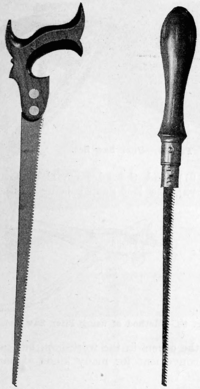A compass saw is a type of saw used for making curved cuts known as compasses, particularly in confined spaces where a larger saw would not fit.[1][2]
Characteristics[edit]
Compass saws have a narrow, tapered blade usually ending in a sharp point, typically with a tooth pitch of 2.5 to 3 mm (eight to ten teeth per inch),[2] but down to 1.3 mm (up to 20 teeth per inch) for harder materials and as long as 5 mm (as few as five teeth per inch) for softer materials.[1] They have a curved, light "pistol grip" handle, designed for work in confined spaces and overhead.[2]
The blade of a compass saw may be fixed or retractable, and blades are typically interchangeable. Partially retracting the blade can prevent flexing and breaking when cutting harder materials.[1]
Compass saws are suitable for cutting softer woods, plastic, drywall, and non-ferrous metals.[1][2] The pointed tip of the blade can be used to penetrate softer materials without the need for a pilot hole.[1]
Comparison with other types of saws[edit]
Compared with other saws designed for cutting curves, such as coping or fretsaws, compass saws have a larger blade and longer pitch (fewer teeth per inch). This allows them to cut faster, and to cut through thicker materials, but leaves a rougher finish.[2]
Compared with drywall saws, compass saws typically have a longer blade – at 15 to 30 centimetres (5.9 to 12 in) – and shorter pitch (more teeth per inch).[1][2]
Keyhole saws, also called padsaws or jab saws, feature shorter, finer blades and (often) straight handles, and are suitable for cutting extremely tight curves.[2][3]
References[edit]
- ^ a b c d e f "What is a Compass Saw?". WiseGeek. Archived from the original on 7 September 2015. Retrieved 7 October 2015.
- ^ a b c d e f g "What is a compass saw?". Wonkee Donkee. Archived from the original on 17 June 2015. Retrieved 7 October 2015.
- ^ "Keyhole saw". The Worlds of David Darling: Encyclopedia of Alternative Energy. Archived from the original on 6 August 2016. Retrieved 7 October 2015.
